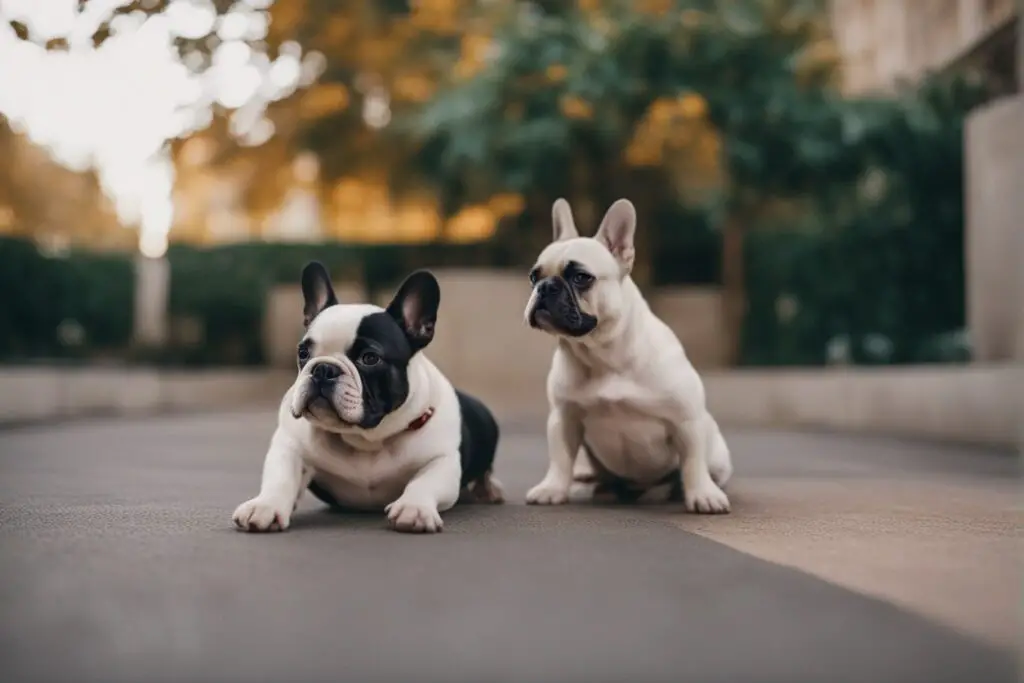Remember the first time you saw a colored Frenchie? Those adorable pups come in various colors, each more heart-melting than the last. But have you ever wondered why that is? It’s all about genetics! Like humans, those colors on your puppy are determined by their genes. And it’s not just about looking cute – there’s a connection between color and health issues. You might’ve noticed that some colored coats are more common than others because some colors can be linked to health problems. So next time you see a yellow Frenchie or any other colored dog, remember there’s a whole background story in their coat!
Table of Contents
- 1 Standard AKC-Approved French Bulldog Colors
- 2 The Unique Appeal of Pied French Bulldogs
- 3 Exploring Sable, Fawn, and Brindle Varieties
- 4 Understanding Merle French Bulldogs Health Concerns
- 5 Decoding Rare Blue and Isabella Varieties
- 6 French Bulldogs Coat Patterns Insights
- 7 Wrapping it Up
- 7.1 FAQs
- 7.2 What are the standard AKC-approved French Bulldog colors?
- 7.3 Are some French Bulldog colors linked with health problems?
- 7.4 How common are blue and Isabella-colored French Bulldogs?
- 7.5 Can I predict my Frenchie puppy’s final color?
- 7.6 What does “pied” mean when referring to a French Bulldog’s color?
- 8 Related posts:
- 9 Why French Bulldog Puppies are the Ultimate Apartment Companions
- 10 Unleashing the French Bulldog Personality: Facts & Traits
- 11 French Bulldog Puppies (25 Perfect Pups)
- 12 10 Fascinating Fun Facts About French Bulldogs
Standard AKC-Approved French Bulldog Colors
The American Kennel Club (AKC) has set breed standards for French Bulldogs, including approved colors. The standard colors are recognized due to their genetic stability and health implications.

AKC’s Color Standards
Here’s the scoop on the AKC’s standard colors for French Bulldogs:
- Brindle: A mix of black hairs in a solid color.
- Fawn: Ranging from light tan to mahogany.
- Cream: Lighter than fawn, almost a pure white.
- White: Pure white with no markings or patches.
Non-standard colors include black, blue, chocolate, merle, and lilac. The AKC doesn’t recognize these because they’re linked to genetic health issues.
Why Some Colors Are Approved, And Others Aren’t
Ever wonder why some colors cut while others don’t? It boils down to genetics. Standard colors are tied to healthier genes. Non-standard ones can lead to potential health risks like deafness or blindness. So it’s not just about looks; it’s about keeping our furry friends healthy!

Importance Of Adherence To Standards For Breeders
For breeders, sticking to these standards matters big time! Here’s why:
- Healthier Pups: Breeding standard-color dogs means healthier offspring.
- Reputation: A breeder’s reputation hinges on producing pups that meet the AKC breed standard.
- Ethical Breeding Practices: Adhering to these rules promotes ethical breeding practices.
So next time you see a French Bulldog in one of those classic shades of brindle, fawn, cream, or pure white – remember there’s more than meets the eye! It’s all about maintaining those good genes and promoting doggy health across every litter of adorable little Frenchies!
The Unique Appeal of Pied French Bulldogs
Pied French Bulldogs, or as some call them, fluffy Frenchies, are a sight to behold. Their coat is a mix of two colors, usually white and another color like black or chocolate. This unique-looking bulldog has patches of color on its feet, face, and sometimes even their eyebrows.

Why are these pied pups so popular? It’s easy to see why:
- They have an adorable look that sets them apart from other French bulldogs.
- Each one is unique. No two pied Frenchies have the same pattern.
- Their coloring doesn’t affect their health in any significant way.
As for health implications associated with pied coloring, there aren’t many. They can sometimes be prone to skin issues due to their white fur. But generally, they’re just as healthy as cream or black Frenchies.
The price for these puppies might be a bit higher because of their rare color pattern. But who can put a price on such a unique-looking dog?
So if you’re considering adding a new member to your family and want something different than the usual cream or chocolate Frenchie, consider getting yourself a pied pup! With eye-catching colors and patterns, these dogs will turn heads wherever you go.

Remember though – whether fluffy Frenchies or cream ones – all French Bulldogs deserve love and care! So make sure you’re ready for the responsibility of owning one of these beautiful dogs before bringing one home.
Exploring Sable, Fawn, and Brindle Varieties
Characteristics of Bulldog Colors
Bulldogs come in a variety of coat colors. The sable coloration is often a mix of black dogs with beige or silver fur. The light fawn color variation typically appears as a pale, yellowish tan. Brindle breeds are unique, with brindle stripes creating a distinct pattern on their coats.
- Sable: Mix of black, beige, or silver fur
- Light Fawn: Pale, yellowish-tan coat
- Brindle: Distinct pattern created by brindle stripes
Genetics Behind the Color Variations
Genetics plays an essential role in breeding practices for these color variations. Many breeders focus on specific breeding programs to produce desired coat colors. For instance, the red fawn color is often sought after due to its rarity.

- Sable: Complex genetic factors contribute to this rare coat color.
- Light Fawn: Common among many bulldog breeds due to dominant genes.
- Brindle: Resulting from a specific gene causing the brindle pattern.
Comparing Sable vs. Fawn vs Brindle Bulldogs
When comparing these three varieties – sable, light fawn, and brindle – there are apparent differences:
| Characteristic | Sable | Light Fawn | Brindle |
|---|---|---|---|
| Rarity | High | Low | Medium |
| Coat Coloration | Mixed (black/beige/silver) | Yellowish Tan | Patterned (brindled) |
| Breeding Difficulty | Complex (rare genes) | Easy (dominant genes) | Moderate (specific gene required) |
Remember that all French Bulldogs make great pets regardless of the breed’s colors! So whether you’re drawn to the mixed hues of sable, the soft tones of light fawn, or the bold brindle pattern, each offers its unique charm!

Understanding Merle French Bulldogs Health Concerns
Merle French Bulldogs, known for their unique coat patterns, carry the Merle gene. This gene can cause a host of health problems.
The Merle Gene and Health Complications
The Merle gene causes patches of color in a dog’s coat. But it’s not all about looks. This gene is linked to several health conditions:
- Deafness
- Eye defects
- Skin sensitivity to sunlight
These issues are because the merle gene affects melanin production, crucial for the normal development of the ears and eyes.
Health Concerns Specific to Merle French Bulldogs
Merle French Bulldogs are at risk for certain health complications. These include:
- Vision problems may increase the risk of cataracts and other eye disorders.
- Hearing loss: Deafness can occur in one or both ears.
It’s worth noting that these health risks can vary significantly between individual dogs.

Breeding Practices Matter
Responsible breeding practices play a crucial role in preventing these health concerns. Here’s why:
- Avoid breeding two merles: This increases the chances of puppies inheriting two copies of the merle gene, leading to more severe health issues.
- Regular vet check-ups: Early detection can help manage potential health conditions better.
By understanding these risks, we can ensure our furry friends live long, healthy lives! Remember, a dog’s color doesn’t determine its worth – its loving nature genuinely matters!
Decoding Rare Blue and Isabella Varieties
The Rarity Factor
Blue and Isabella French bulldogs? Yeah, they’re the unicorns of the Frenchie world. These rare colors aren’t just a fashion statement. They’re a result of some severe genetic roulette.

- Blue color: This isn’t your everyday blue. It’s more like a grayish-blue coat with a hint of silver. The blue base comes from a recessive gene, meaning both parents must pass it on.
- Isabella: A brown base that looks lilac or pale chocolate? That’s Isabella for you! This rarer color is also due to a recessive gene, specifically the chocolate gene.
But why are these colors so rare?
- Not every Frenchie carries these genes.
- Even if they do, it takes two to tango – both parents need copies of the same gene for their pup to sport these shades.
Genetics Behind the Coat
The genetic code behind these colors is intriguing:
- Blue eyes: A common feature in blue Frenchies due to lack of pigmentation.
- Yellow eyes: Some Isabellas might have them, thanks to the cocoa gene.
- Tan markings and white patch: Possible extras in this wide range of coat variations.
Health Risks
But wait, there’s more! These rare coats come with potential health risks:
- Color dilution alopecia (CDA): More common in blue Frenchies, leading to hair loss and skin issues.
- Chocolate toxicity: No, not that kind of chocolate! We’re discussing potential health issues linked with the chocolate gene in Isabellas.

So remember, folks, while these rare colors may give your Frenchie some extra street cred, they can also come with some unexpected baggage. Always know what you’re signing up for when choosing your furry friend!
French Bulldogs Coat Patterns Insights
Coat Patterns vs. Colors
Let’s cut to the chase; dog breeds like French Bulldogs have more than just color variations. They also rock different coat patterns. The color pattern is what you see on the surface, like black or white. But design refers to how those colors layout on the skin.
For instance, some Frenchies might have a base coat of fawn with brindle patches. Or they could sport a solid black jacket without any markings or patterns.
Common Coat Pattern Types
French Bulldogs display an array of unique patterns:
- Brindle: Dark streaks over a lighter base coat.
- Piebald: White base with patches of another color.
- Merle: Mottled patches and speckles on the skin.
- Ticked: Small spots of color on white fur.
The Role of Genetics
Have you ever wondered how your Frenchie ended up with that cool mask? Well, it’s all in their genes!
Genetics play a significant role in determining the color and pattern of a French Bulldog’s coat. Specific genes control where and when color will be produced in each hair follicle.
So next time you admire your Frenchie’s unique patterns, remember – it’s not just about looks! It’s also about science and genetics working together to create these beautiful and diverse dog breeds we love!

Wrapping it Up
So, there you have it! French Bulldogs are a rainbow of options, from the standard AKC-approved colors to the rare and exotic hues. It’s not just about picking your favorite color, though. You’ve learned how specific colors can come with health concerns, like in Merle Frenchies, so choosing wisely is critical.
Now that you’re practically a pro on Frenchie colors and coat patterns, why not put that knowledge to use? Whether you’re planning to get a new pup or want to show off your newfound expertise at the dog park, remember – every Frenchie is unique and special!
FAQs
What are the standard AKC-approved French Bulldog colors?
The American Kennel Club recognizes nine standard colors for French Bulldogs: white, cream, fawn (ranging from light fawn to red fawn), and several brindle variations.
Are some French Bulldog colors linked with health problems?
Yes. For instance, Merle French Bulldogs often face health issues like deafness and eye problems due to their distinctive coloring gene.
How common are blue and Isabella-colored French Bulldogs?
Blue and Isabella-colored Frenchies are pretty rare. They carry a dilute gene responsible for their unique color but also makes them less common.
Can I predict my Frenchie puppy’s final color?
While puppies may change color as they grow older, their final adult coat will usually be apparent by around one year
What does “pied” mean when referring to a French Bulldog’s color?
A pied Frenchie has a primarily white coat with patches of another color. The pattern varies greatly from dog to dog.